System Of Equation No Solution
When working with systems of linear equations, we oftentimes see one or infinitely many solutions. Nonetheless, it is also possible that a linear arrangement will have no solution.
So, when does a system of linear equations have no solution? A system of 2 linear equations in two variables has no solution when the two lines are parallel. From an algebra standpoint, this means that we get a false equation when solving the system. Visually, the lines never intersect on a graph, since they accept the aforementioned slope but different y-intercepts.
Of grade, a arrangement of iii equations in 3 variables has no solution if at that place is no bespeak where all 3 planes intersect.
In this commodity, we'll talk about how y'all can tell that a arrangement of linear equations has no solution. Nosotros'll also look at some examples of linear systems with no solution in 2 variables and in 3 variables.
Let's begin.
Systems Of Linear Equations With No Solution
A organization of linear equations tin have no solution if the equations are inconsistent. This means that in that location is no point that can satisfy all of the equations at the same time.
The image below summarizes the 3 possible cases for the solutions for a system of 2 linear equations in 2 variables.
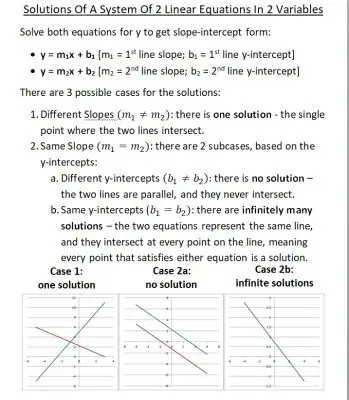
A system of equations in 2, 3, or more variables tin can have no solution. We'll start with linear equations in 2 variables with no solution.
When Does A Linear System Have No Solution? (Arrangement Of Linear Equations In 2 Variables)
There are a few ways to tell when a linear system in two variables has no solution:
- Solve the system – if you lot solve the organization and become a nonsense equation (such as 0 = 1), then in that location is no solution.
- Look at the graph – if the two lines are parallel (they never touch), and so in that location is no solution to the arrangement.
- Await at the slope and y-intercept – solve both equations for y to get slope-intercept class, y = mx + b. If the two equations have the same gradient, but different y-intercepts, then the lines are parallel and at that place is no solution (you lot tin can get a refresher on how to tell when two lines are parallel in my commodity here).
We'll look at some examples of each example, starting with solving the system.
Solving A Linear System With No Solution
When we effort to solve a linear organization with no solution, we will become a nonsense equation equally a issue. For case, later on we simplify and combine like terms, we volition get something similar 0 = 1 or 2 = 5.
Let's accept a expect at some examples to see how this can happen.
Example 1: Using Elimination To Show A Linear System Has No Solution
Let'southward say we desire to solve the following system of linear equations:
- 3x + 4y = 9
- -6x – 8y = 10
We will utilize elimination to solve. Let'south try to eliminate the "x" variable.
We begin by multiplying the first equation by 2 to become:
- 2(3x + 4y) = two(9) [multiply the showtime equation by 2 on both sides]
- 6x + 8y = 18 [distribute the 2 through parentheses]
At present we add this modified equation to the second one:
6x + 8y = 18
+
-6x – 8y = x
___________
0x – 0y = 28
0 = 28
Since this equation is nonsense (it tin can never be true), this tells us that there is no solution to this organisation of linear equations. The graph beneath confirms that the lines are parallel and have no solution (they never intersect).
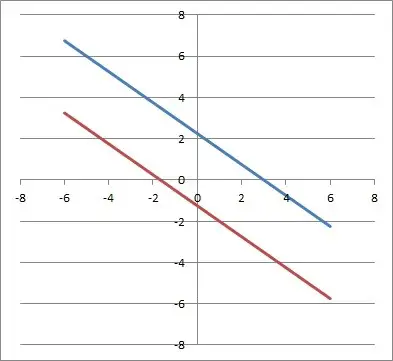
Example 2: Using Commutation To Prove A Linear System Has No Solution
Let's say we desire to solve the following system of linear equations:
- y = 2x + 5
- y = 2x + 8
We will utilize substitution to solve. We'll substitute the y from the first equation into the y in the second equation:
- y = 2x + eight [first with the 2d equation]
- 2x + 5 = 2x + eight [substitute y = 2x + v from the first equation]
- 2x – 2x = eight – 5 [put like terms on both sides]
- 0x = 3 [combine like terms]
- 0 = iii
Since this equation is nonsense (it can never be true), this tells us that in that location is no solution to this organisation of linear equations. The graph below confirms that the lines are parallel and have no solution (they never intersect).

Looking At The Graph Of A Linear System With No Solution
When we graph a linear arrangement with no solution, we will get ii parallel lines that never intersect.
Let's take a look at some examples to run across how this can happen.
Example 1: Graph Of 2 Parallel Lines From A Linear Organization With No Solution
Let'south graph the post-obit system of linear equations:
- y = -3x + four
- y = -3x – 2
Both lines volition have a slope of -3, but they have different y-intercepts, equally you can see in the graph beneath:
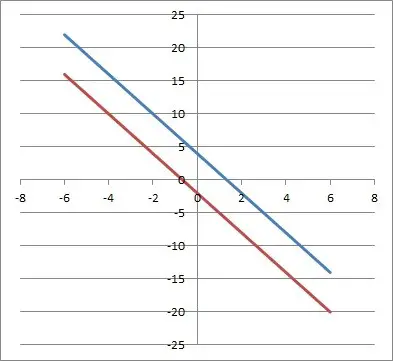
Since the lines are parallel, they will never intersect. This means that there is no solution to the linear organisation we started with (there is no point that lies on both lines).
Example ii: Graph Of Two Parallel Vertical Lines From A Linear System With No Solution
Let's graph the post-obit organization of linear equations:
- y = v
- y = -three
Both lines will accept a slope of 0, but they have different y-intercepts, equally you can see in the graph beneath:
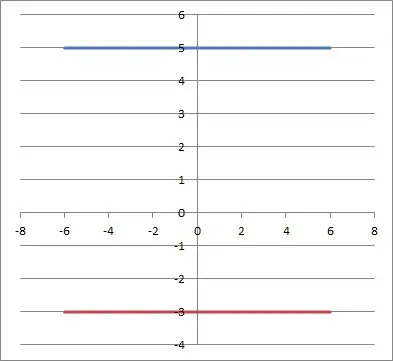
Since the lines are parallel, they will never intersect. This means that at that place is no solution to the linear organization we started with (at that place is no bespeak that lies on both lines).
Example 3: Graph Of Two Parallel Horizontal Lines From A Linear System With No Solution
Allow'due south graph the following organization of linear equations:
- x = 2
- x = -four
Both lines will have an undefined slope, since they are vertical lines. They besides have no y-intercept, but they are parallel, every bit y'all can come across in the graph below:
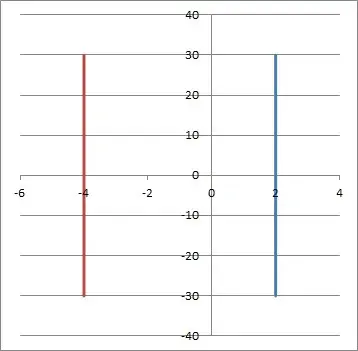
Since the lines are parallel, they will never intersect. This ways that there is no solution to the linear organisation we started with (there is no point that lies on both lines).
Looking At The Slope & Y-Intercept Of A Linear System With No Solution
When nosotros solve a linear equation for y, we get slope-intercept class. If we do this for both equations in a linear system, we can compare the slope and y-intercept.
If the two slopes are the same and the y-intercepts are different, then the two lines are parallel, meaning they never intersect and in that location is no solution to the linear organisation.
Let's take a expect at some examples to see how this can happen.
Instance 1: Comparison Gradient & Y-Intercept To Show At that place Is No Solution To A Arrangement Of Two Linear Equations
Let'southward say we have the following organisation of linear equations:
- 4x = – 2y + eight
- 3y = -6x + nine
We will solve for y in both equations to get slope-intercept form, y = mx + b.
Solving the first equation for y, we get:
- 4x = – 2y + 8
- 4x + 2y = 8 [add 2y to both sides]
- 2y = -4x + 8 [subtract 4x from both sides]
- y = -2x + 4 [carve up by 2 on both sides]
Solving the 2nd equation for y, we go:
- 3y = -6x + 9
- y = -2x + iii [divide past 3 on both sides]
Then, the two equations in slope-intercept grade are:
- y = -2x + 4
- y = -2x + iii
Since these two equations accept the aforementioned slope (g = -2) and dissimilar y-intercepts (4 and three), we know that the 2 lines are parallel. Since the lines never intersect, at that place is no solution to the system (no signal that is on both lines).
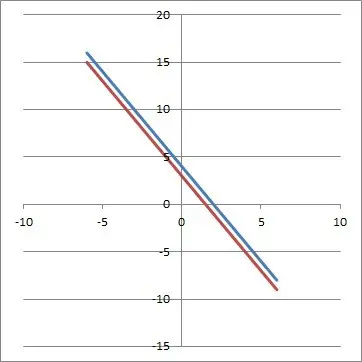
Example 2: Comparing Slope & Y-Intercept To Show There Is No Solution To A Organization Of Two Linear Equations
Let's say nosotros have the following system of linear equations:
- 40x = 5y – 15
- 4y – 32x + five = 13
We volition solve for y in both equations to become slope-intercept form, y = mx + b.
Solving the outset equation for y, nosotros become:
- 40x = 5y – 15
- 40x + 15 = 5y [add 15 to both sides]
- 8x + 3 = y [divide by 5 on both sides]
Solving the second equation for y, we get:
- 4y – 32x + five = 13
- 4y – 32x = thirteen – 5[subtract five from both sides]
- 4y – 32x = viii[combine like terms: constants]
- 4y = 32x + 8 [add 32x to both sides]
- y = 8x + 2 [divide by 4 on both sides]
And then, the two equations in gradient-intercept form are:
- y = 8x + iii
- y = 8x + ii
Since these 2 equations have the same slope (m = eight) and different y-intercepts (3 and 2), nosotros know that the two lines are parallel. Since the lines never intersect, in that location is no solution to the system (no betoken that is on both lines).
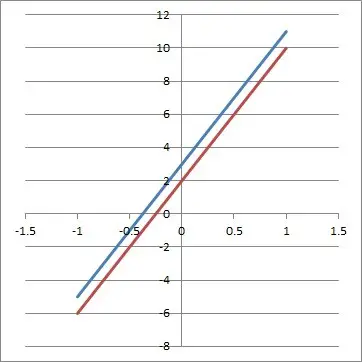
How To Create A System Of Linear Equations With No Solution
To create a system of linear equations with no solution, we tin take a couple of approaches:
- 1 method is to kickoff with a "nonsense" equation and add variables until nosotros get 2 linear expressions, ane on each side of the equation.
- Another method is to write two lines in gradient-intercept form y = mx + b, where the slopes are the same and the y-intercepts are unlike.
Allow'southward try each method in plough.
Example 1: Create A Arrangement Of Linear Equations With No Solution
Allow'due south offset with the nonsense equation
- 0 = ane
Now we'll add x to both sides:
- x + 0 = x + 1
- x = x + 1
Adjacent we'll multiply past 3 on both sides:
- 3x = 3x + 3
At present we take a linear expression on each side of the equation, and we can use these two give us the equations of two lines that never intersect:
- y = 3x [from the left side of the equation in a higher place]
- y = 3x + 3 [from the right side of the equation to a higher place]
You can see that these lines are parallel from the graph below, meaning there is no solution to the system.
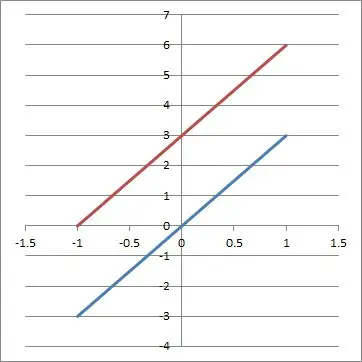
Example ii: Create A Organization Of Linear Equations With No Solution
Let's write the equations of two lines in slope-intercept class (that is, y = mx + b) with the same slope and different y-intercepts.
We'll use a common gradient of 2, with y-intercepts of five and seven:
- y = 2x + 5 [slope of 2, y-intercept of v]
- y = 2x + seven [slope of 2, y-intercept of 7]
You can run into that these lines are parallel from the graph below, significant there is no solution to the organisation.
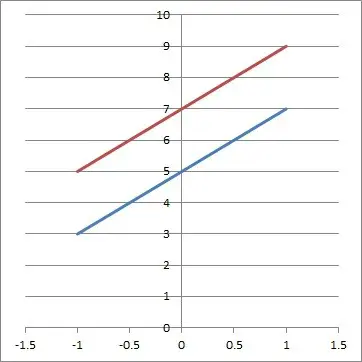
System Of Linear Equations In Three Variables With No Solution
A system of equations in 3 variables volition have no solution if there is no signal where the 3 planes all intersect. This can happen if:
- The planes are all "parallel" (they never intersect one another at all).
- Two planes may intersect, merely never all 3 at once.
Here is an example of the showtime case:
- x + y + z = 1
- 10 + y + z = two
- x + y + z = three
Note that all of these aeroplane equations have the same expression on the left side, but different constants on the right side.
In the same way that x = ane and x = two cannot be truthful at the aforementioned fourth dimension, we can likewise say that x + y + z = 1 and x + y + z = 2 cannot be truthful at the same time.
This means that there is no solution to the above system.
When Does A System Of Linear Equations Take A Solution?
A arrangement of linear equations in two variables has a solution when the two lines intersect in at least one place.
- If the two lines have the same slope and the same y-intercept, then the 2 equations are equivalent, and they represent the aforementioned line (and then there are infinitely many solutions, since every point on the line is a solution).
- If the two lines take dissimilar slopes, then they intersect at exactly 1 point.
Conclusion
At present you know when a system of linear equations has no solution. You too know what to wait out for in terms of the slope, y-intercept, and graph of lines in these systems.
Yous can larn about systems of linear equations with one solution in my article here.
You lot might also find information technology helpful to read my commodity on systems of linear equations with infinite solutions.
You can learn more well-nigh gradient in this article.
I promise you found this article helpful. If so, please share it with someone who tin use the data.
Don't forget to subscribe to my YouTube channel & get updates on new math videos!
~Jonathon
System Of Equation No Solution,
Source: https://jdmeducational.com/systems-of-linear-equations-with-no-solution-3-ways-to-tell/
Posted by: bowennack1994.blogspot.com


0 Response to "System Of Equation No Solution"
Post a Comment